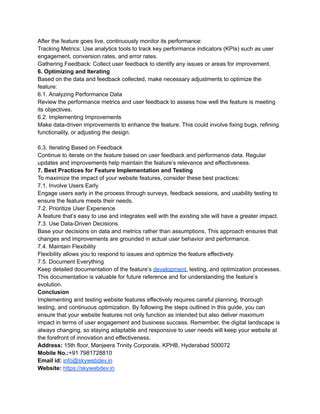Measuring PPC ROI: Understanding Your Ad Spend
Calculating CPA involves a straightforward formula: Total Advertising Spend divided by the Number of Conversions. For instance, if you spent $1,000 on advertising and generated 50 conversions, your CPA would be $20. This simple calculation allows you to quickly assess the financial performance of your PPC campaigns and identify areas for improvement.
Accurate tracking of both spending and conversions is paramount. Reliable analytics tools are crucial for collecting this data. Using a tool that provides a clear breakdown of your advertising costs and associated conversions enables informed decision-making and strategic adjustments to your PPC campaigns.
Key Factors Influencing Your CPA
Several factors significantly impact your CPA, including ad quality, keyword relevance, landing page optimization, and bidding strategies. High-quality ads that resonate with your target audience are more likely to generate conversions at a lower cost. Keyword research that targets highly relevant terms and landing pages that effectively guide visitors to conversions are critical factors.
Bidding strategies, particularly automated bidding options, can also influence CPA. Understanding how these factors interact and adjusting them accordingly will result in a more efficient and profitable PPC campaign.
Optimizing Your CPA for Maximum ROI
Optimizing your CPA is a continuous process that requires ongoing analysis and adaptation. Monitoring your CPA alongside other key performance indicators (KPIs) like click-through rates (CTR) and conversion rates is essential. Analyzing trends and identifying areas for improvement, such as refining your target audience, refining ad copy, and improving landing pages, are crucial for long-term success.
Using CPA Data to Improve Campaigns
CPA data provides valuable insights into campaign performance. By tracking CPA over time, you can identify trends and understand how different elements of your campaigns impact your cost per acquisition. Using this data to adjust your bidding strategies, target audience, and ad copy will allow for continuous optimization and improvement of your ROI.
Regularly reviewing CPA data helps you identify areas where your campaigns are performing well and areas where they need improvement. This iterative process allows you to refine your strategies and ensure that your PPC investments are yielding the best possible results.
CPA and Your Overall PPC Strategy
CPA is an integral component of a comprehensive PPC strategy. By incorporating CPA data into your broader marketing plan, you can make informed decisions about budget allocation, targeting strategies, and campaign optimization. Analyzing CPA alongside other metrics, like click-through rate and conversion rate, gives you a holistic view of your campaign performance and allows for data-driven adjustments.
Integrating CPA analysis into your broader marketing initiatives provides a comprehensive understanding of your return on investment (ROI). This comprehensive approach is crucial for making strategic decisions that align with your overall business objectives and optimize your PPC campaigns for maximum effectiveness.
The camshaft position sensor (CPS) plays a crucial role in regulating fuel delivery to the engine. Its primary function is to accurately measure the position of the camshaft, providing crucial timing information to the engine control module (ECM). This information is essential for the ECM to determine when to inject fuel into the cylinders. Without precise data from the CPS, the fuel injectors may open at the wrong time, leading to inconsistent fuel-air mixtures. This irregularity can result in reduced engine performance, poor fuel economy, and potentially, engine damage over time.

Beyond the Numbers: Qualitative Metrics
Beyond the Clicks: Understanding Customer Journey
While click-through rates and conversion rates are crucial for quantifying PPC success, a deeper understanding of the customer journey is often overlooked. Qualitative data, collected through surveys, user interviews, and A/B testing, can reveal critical insights into how users interact with your ads, landing pages, and overall brand experience. This qualitative data helps identify pain points in the sales funnel and opportunities for improvement, such as addressing specific customer concerns or refining messaging. Understanding user behavior, beyond simply clicks and conversions, is paramount for optimizing your PPC campaigns in the long run. For example, if user surveys reveal a recurring theme of confusion about product features, adjusting your ad copy or landing page content to clarify these points can dramatically improve conversion rates.
Analyzing qualitative data allows for a more nuanced perspective on your PPC efforts, going beyond the simplistic metrics. This approach can reveal underlying issues that quantitative data might miss, like a disconnect between ad messaging and customer expectations. Identifying these issues allows for more strategic refinements to your overall marketing strategy, ensuring a more cohesive and effective user experience. A strong customer journey is not just about driving clicks; it's about building trust and understanding your target audience, which ultimately leads to higher ROI in the long term.
The Human Element: Improving Brand Perception
PPC campaigns aren't just about driving traffic; they're about building brand perception and establishing trust with potential customers. Qualitative feedback, including reviews, social media mentions, and online forums, provides invaluable insight into how your brand is perceived. Monitoring these interactions allows you to address negative sentiment proactively and identify areas where your brand messaging resonates positively with the target audience. Understanding how your brand is perceived, beyond the numbers, can reveal opportunities for targeted ad copy improvements to showcase your brand's unique value proposition.
Analyzing qualitative data from customer interactions helps fine-tune your approach to building brand loyalty. This data-driven insight enables you to tailor your ad campaigns to better reflect your brand's identity, thereby creating a more personalized and compelling customer experience. For example, if negative feedback highlights a lack of transparency in your return policy, addressing this concern in your ad copy can build trust and mitigate potential issues before they arise. This proactive approach, focused on qualitative insights, results in a more sustainable and effective PPC strategy.
Qualitative data, while often more challenging to quantify, is crucial for understanding the human element behind your PPC campaigns. It allows you to move beyond a purely transactional approach and build meaningful relationships with your target audience. By understanding how your brand is perceived, you can create a more engaging and trustworthy experience, leading to a more substantial and long-lasting return on investment.











